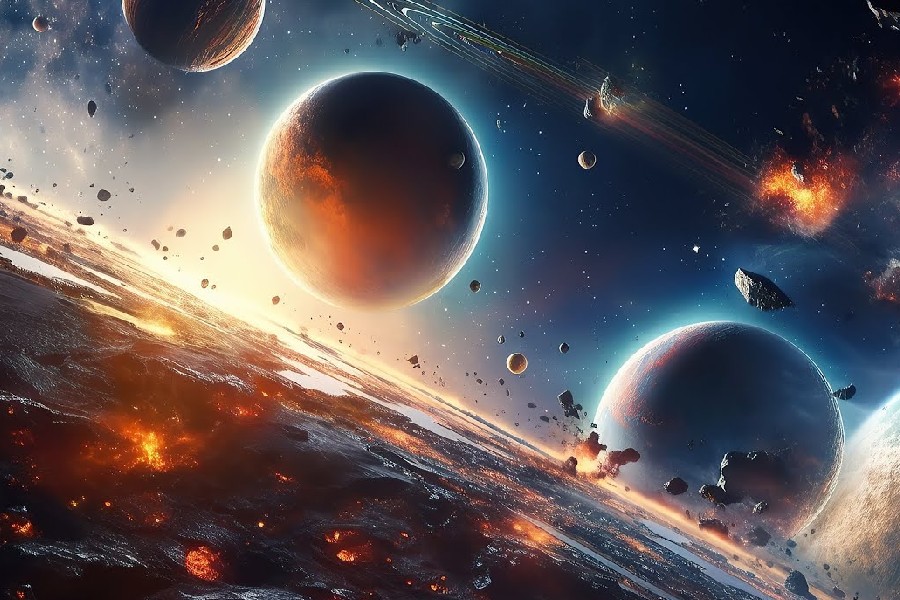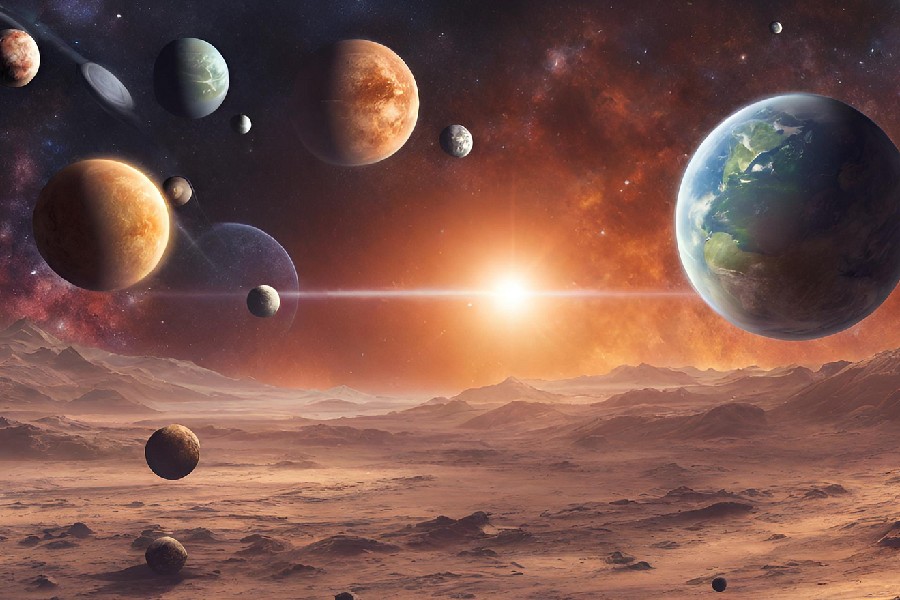We believed our galaxy encompassed all of existence. But modern physics now suggests many universes could exist parallel to each other, profoundly expanding reality’s scale. How many universes are there? The idea of a “multiverse” remains speculative and divisive among scientists, some of whom dismiss it entirely.
Yet evidence emerges hinting that our universe might comprise only one small part of a far grander totality fundamentally beyond perception or travel capabilities. Read on as we unpack this fascinating concept through questions like – what types of parallel universes could exist? How could they form?
What evidence possibly supports their presence? And what does the multiverse theory say about the specialness of our home among unfathomably immense celestial spheres? Keep reading to learn more!

How Many Universes Are There?
So, how many universes are there? The actual number of universes remains unknown. Advances in physics suggest a cosmic “multiverse” beyond our observable universe. This network of universes features radically different physical laws.
Hypothetical parallel universes like quantum or daughter realms constitute the multiverse. Proposed formation mechanisms include inflation, colliding membranes, and quantum fluctuations.
Communication is likely impossible between universes. Total tally elusive with infinity’s scope beyond current knowledge. Further breakthroughs are needed to reveal the potential extent of reality and roughly enumerate how many universes may exist.
The Multiverse Hypothesis
Multiverse theory
A vast cosmic reality
The multiverse suggests many universes exist beyond our observable one. This hugely expands the conceptualization of reality. Unproven, but evidence emerges in support of the idea that our universe is just one small part of a vast cosmic network of other realms.
Conceptual origins
Predictions of quantum mechanics indicate multiple outcomes simultaneously occur. Alongside string landscape calculations and cosmic inflation models, these point to parallel universe existence as explanations. Thought experiments also contributed frameworks.
Together these origin lines suggest a coherent multiverse model – a vast network of other universes comprising a greater cosmos.
Key models and variants
Numerous conceptual models for parallel universes exist under the multiverse banner. Universes continuously emerge from our own, resembling bubbles in boiling water.
At decision points, quantum branches lead to diverse, accessible realities, while mathematical spaces host alternative modes of existence within additional dimensions beneath observable physics. Extra dimensions separate universes, influencing time flow and fundamental physical constants.
Some feature alternate histories or laws of physics than our observable realm. Myriad configurations are hypothesized in the scientific literature, each presenting its own questions and curiosities and inviting further examination through scientific philosophy into the potential structure of reality.
Supportive theoretical physics
Quantum mechanics links
Quantum mechanics governs subatomic particles. Key principles include superposition and entanglement. The math indicates multiple coexisting outcomes for particles before observation. This implies many alternate histories and realities.
The Many-Worlds Interpretation of quantum mechanics suggests these coexisting realities manifest as parallel universes. Quantum measurement collapses superpositions into definite outcomes and splits universes. Thus, quantum mechanics provides a conceptual foundation for the multiverse idea.
Inflationary cosmology connections
The theory of cosmic inflation holds that the early universe exponentially expanded in a tiny fraction of a second, right after the Big Bang. Models show inflation can perpetually generate more inflating space.
Eternal inflation predictions indicate inflation creates infinite pocket universes ballooning out as new cosmic realms disconnected from each other in growth cycles past and future. This assemblage of cosmic bubbles provides another framework supporting the possibility of a vast multiverse.

Types of Multiverse Concepts
Level I – Universes beyond the observable horizon
Greater cosmos hidden
Space beyond our cosmic horizon hides mysteries. As space-time expands, more comes into view. Light from the start, Big Bang afterglow, set visibility limit.
Unseen realms could stretch without end. Continued expansion implies space and universes extend past observed boundaries. Density fluctuations like early seeds for galaxy clusters suggest self-similarity over greater scales.
Implications of further expansion
A vast realm of uncounted universes may await discovery. The scale of reality could be exponentially greater than the observable universe we can currently see. What other cosmic wonders and alien physics might exist past the boundaries of our known space-time?
Level II – Bubble universes
Eternal inflation dynamics
The theory of eternal inflation posits exponential spatial expansion in tiny timeframes right after the Big Bang. This rapid swelling creates detached “bubble” universes, each with its own dimensions.
Laws and physics alteration
Within these bubble universes, basic physics constants may differ. Nuclear forces, lightspeed, and gravity effectiveness could vary. Each cosmic bubble is a separate realm with distinct science laws, isolated from peers by inflating space boundaries.
Level III – Many-worlds branches
Quantum mechanics splitting
In quantum mechanics, subatomic particles act as probability waves until measurement forces definite values. Many-Worlds theory says each quantum outcome splits reality into parallel branches.
Parallel realities result
So every possible quantum outcome occurs across alternate histories and universes according to Many-Worlds Interpretation. Decision chains result in the exponential proliferation of parallel realities – diverging worlds just as real as other branching paths.
Speculative Concepts Beyond Multiverse
Alternative hypotheses
Some ideas speculate possibilities more exotic than typical multiverse theories. These include hypotheses of simulated digital universes existing in an advanced computer program, claims that only a single universe exists with no multiverse, and brane cosmological constructs consisting of multiple dimensions anchored by membranes.
String theory predicts extra tiny, curled dimensions beyond normal 3D space and time. Vibrations within these tiny dimensions could resonate across the many theoretical parallel universes in string theory. This raises the question – might fundamental harmonic patterns intrinsically interlink these multitudes of potential cosmic realities?
Intricate numerical patterns and mathematical symmetries potentially indicate a fundamental harmonic order underlying the fabric of reality itself. This hypothetical profound order could intrinsically weave together matter, energy, and quantum properties across parallel worlds or universes.
Subtle quantum and high-energy research offers chances to uncover profound interconnections in reality. It might illuminate how mathematical structures might encode multidimensional order in the cosmos.
Intersections with philosophy and fiction
While cosmology has arrived at parallel worlds theoretically through quantum and inflation models, philosophers and fiction authors have long contemplated similar multidimensional realities:
- Ancient religious texts depicted heavenly realms beyond the mortal plane
- Renaissance philosophers conceptualized island worlds existing simultaneously
- Science fiction has portrayed characters accessing alternate timelines and parallel dimensions through space-time portals
These diverse fields are linked by shared intuitions about layers to reality exceeding a subjective personal experience. While scientific theories strive to substantively back extradimensional claims with equations and observation, fiction has a free hand in attempting to imagine the nature of broader reality.
In the end, the multiverse hypothesis echoes timeless human impulses – to imagine, reason, and portray realities greater than those available to direct observation.
Conclusion
As we’ve seen, fundamental questions remain regarding the nature of the multiverse beyond the boundaries of our observable cosmic horizon.
Yet, from quantum probabilities to eternal inflation’s bubble universes to hidden realms beyond light’s reach, clues emerge pointing to realities far exceeding imagination’s grasp. So, how many universes are there?
While we don’t have a conclusive answer, even conservative interpretations outline a scale of creation radically vaster than we ever dared conceive. Faced with such a vast scale, the meaning we assign to existence floats into an unbounded space of possibility.
This article has aimed to provide guideposts for comprehending the enormity described by multiverse proposals and their profound implications. Yet numbers fail to capture the truth’s depth. We must journey further into speculative scientific cosmology to discover reality’s true extent.
No matter how much we stretch our theories, understanding the variety of existence is challenging. We eagerly await what new discoveries may unfold as cosmic eras progress.
